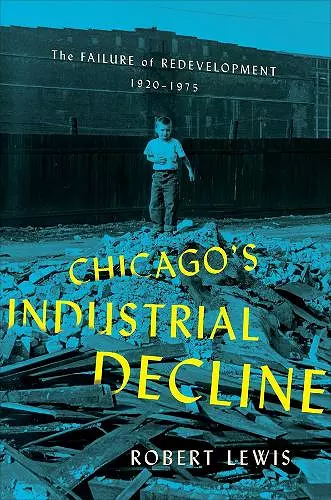Chicago's Industrial Decline
The Failure of Redevelopment, 1920–1975
Format:Hardback
Publisher:Cornell University Press
Published:15th Dec '20
Currently unavailable, and unfortunately no date known when it will be back

In Chicago's Industrial Decline Robert Lewis charts the city's decline since the 1920s and describes the early development of Chicago's famed (and reviled) growth machine. Beginning in the 1940s and led by local politicians, downtown business interest, financial institutions, and real estate groups, place-dependent organizations in Chicago implemented several industrial renewal initiatives with the dual purpose of stopping factory closings and attracting new firms in order to turn blighted property into modern industrial sites. At the same time, a more powerful coalition sought to adapt the urban fabric to appeal to middle-class consumption and residential living. As Lewis shows, the two aims were never well integrated, and the result was on-going disinvestment and the inexorable decline of Chicago's industrial space.
By the 1950s, Lewis argues, it was evident that the early incarnation of the growth machine had failed to maintain Chicago's economic center in industry. Although larger economic and social forces—specifically, competition for business and for residential development from the suburbs in the Chicagoland region and across the whole United States—played a role in the city's industrial decline, Lewis stresses the deep incoherence of post-WWII economic policy and urban planning that hoped to square the circle by supporting both heavy industry and middle- to upper-class amenities in downtown Chicago.
As Lewis demonstrates in this insightful case study, between 1879 and 1919, 75 percent of the 430,000 new manufacturing jobs created in the metropolitan area were within city limits. The author focuses on the slow but cumulatively significant decline that began around 1920, so that by 1972 manufacturing employment had decreased by more than 25 percent. Many locally established industries and new ones alike relocated to outlying areas, especially after WWII. Lewis explores the reasons for this shift; however, the most important aspect of his project is his analysis of the complicated factors related to why concerted efforts to rejuvenate industrial development fell far short of expectations. Urbanists, planners, and historians should find this book valuable.
* ChoiISBN: 9781501752629
Dimensions: 229mm x 152mm x 23mm
Weight: 907g
272 pages